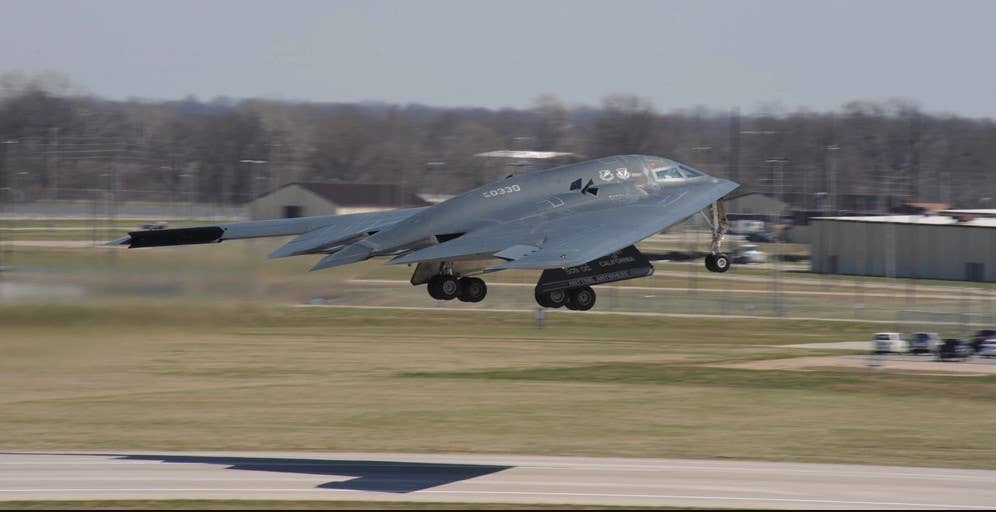B-2 Spirit Bombers Deploy to Australia
The U.S. Air Force stealth bombers flew to Royal Australian Air Force Base Amberley for training and strategic threat deterrence missions.

The stealth bombers belonging to the 509th Bomb Wing arrived at Royal Australian Air Force (RAAF) Base Amberley (YAMB) on Sunday. [U.S. Air Force photo by Senior Airman Bryan Crane]
B-2 Spirit bombers have deployed from Whiteman Air Force Base (KSZL), Missouri, to Australia for training and strategic threat deterrence missions in the Indo-Pacific region, the U.S. Air Force announced.
The stealth bombers belonging to the 509th Bomb Wing arrived at Royal Australian Air Force (RAAF) Base Amberley (YAMB) on Sunday, and are part of a Bomber Task Force (BTF) that routinely rotates strategic bombers in the Indo-Pacific region.
"This deployment of the B-2 to Australia demonstrates and enhances the readiness and lethality of our long-range penetrating strike force,” said Lt. Col. Andrew Kousgaard, 393rd Expeditionary Bomb Squadron commander, in a statement. “We look forward to training and enhancing our interoperability with our RAAF teammates, as well as partners and allies across the Indo-Pacific as we meet [Pacific Air Force] objectives.”
The BTF rotation supports the Enhanced Cooperation Initiative under the Force Posture Agreement between the U.S. and Australia, and comes on the heels of a recent joint training exercise conducted between the two countries.
In late March, a B-2 from Whiteman flew to Amberley for training aimed at boosting interoperability among allies, while also operating in the Indo-Pacific region.
During the spring operation, the B-2 conducted aerial refueling from an Alaska Air National Guard Boeing KC-135 Stratotanker in Australian airspace before joining eight fighter aircraft. Those fighters included:
- Two RAAF Lockheed Martin F-35A Lightning IIs
- Two RAAF Boeing EA-18 Growlers
- Two RAAF Boeing F/A-18F Super Hornets
- Two U.S. Air Force General Dynamics F-16C Fighting Falcons
When the B-2 arrived at Amberley, it marked the first time the aircraft had landed at the Australian air base, according to the U.S. Air Force.
“This is the most consequential theater with the most challenging security issues…and advancing our interoperability with critical allies like Australia is critical to maintaining a free and open Indo-Pacific,” said U.S. Navy Adm. John C. Aquilino, commander of U.S. Indo-Pacific Command, at the time of the March operation. “There are many aspects that are going on daily to continue to move the security relationship forward in a positive way to provide deterrence, prevent war, and maintain peace and stability within the region.”
The training exercises are part of a continued focus on establishing threat deterrence in the region, at a time when China continues to demonstrate aggressive behavior.
In late May, for example, a Chinese fighter jeopardized the crew safety of an RAAF Boeing P-8 Poseidon aircraft when it intercepted the airplane and released debris into its engines while it conducted a routine surveillance flight over the South China Sea, according to Australian defense officials.
Washington’s relationship with China remains one of competition, and not contention, according to U.S. Defense Secretary Lloyd Austin, who also described the Indo-Pacific region as the DOD's "priority theater" during a press conference with reporters while in Thailand.
“We do not seek a new Cold War, an Asian NATO, or a region split into hostile blocs,” Austin said, while speaking at a defense conference held in Singapore in June, the Wall Street Journal reported. “We will defend our interests without flinching, but we’ll also work toward our vision for this region—one of expanding security, one of increased cooperation, and not one of growing division.”

Sign-up for newsletters & special offers!
Get the latest FLYING stories & special offers delivered directly to your inbox






